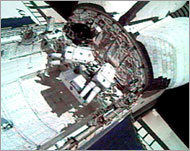Discovery astronauts tackle repairs
Armed with forceps, a makeshift hacksaw and duct tape, a Discovery astronaut rode a robotic arm towards the shuttle’s belly for the unprecedented task of eliminating a potential source of dangerous overheating during the shuttle’s re-entry.

Astronaut Stephen Robinson on Wednesday described his spacewalking job as delicate, but simple: pull out or slice off two dangling pieces of filler material from Discovery’s belly.
Nasa officials determined the exposed ceramic-fibre fillers could lead to overheating and a possible repeat of Columbia‘s disastrous re-entry.
Robinson attached a special foot restraint to the space station’s 58-foot (17.7 metre) robotic arm, and fellow astronauts aboard the station manoeuvred it towards the shuttle’s belly.
Robinson took only the essential tools for the repair – leaving a tile repair kit just outside the airlock.
He also secured his safety tethers between his legs and behind him to prevent accidentally striking the vehicle.
Once under Discovery’s belly, Robinson expected to spend about an hour removing or trimming the fillers from two locations near the shuttle’s nose.
Spacewalking partners
His spacewalking partner, Soichi Noguchi, meanwhile, headed to an area of the station where he could keep an eye on Robinson.
 |
|
Nasa says exposed ceramic-fibre |
He would communicate with astronauts aboard the orbiting complex if Robinson’s communication system failed.
The first gap filler Robinson deals with could be the trickier of the two.
Nasa officials believe it remains glued to a shim that is bonded to a thermal tile.
If a gentle tug does not work, Robinson will pull a little harder with forceps. And if he remains unsuccessful, he will resort to a hacksaw put together in orbit with a deliberately bent blade, plastic ties, Velcro and the handyman’s favourite all-purpose fix-it: duct tape.
Once work is finished at the first location, astronauts planned to reposition the station’s arm so that Robinson could reach the second protruding piece of filler.
Insulation
Nasa thinks that piece – about the thickness of three index cards bonded together – should be easily removed with Robinson’s gloved hand.
“Because of the way this gap filler is sticking up at both ends, it does not appear to be bonded,” Nasa officials told the crew in up-linked materials. “We expect it to slip out easily.”
There are 24,300 glass coated tiles on the shuttle, a majority of them on its belly.
The tiles protect the shuttle from the extreme temperatures in orbit and, more importantly, insulate the ship during launch and re-entry.
|
“Delicate is the word we want to stay with while we are at the bottom of the orbiter. We don’t want to touch the tile if we can avoid it at all” |
The filler material protects the tiles from bumping against one another during launch, but is not needed for landing because of the difference in the airflow.
Before heading to the repair site, the pair spent about two hours installing an external tool and parts platform on the international space station, where Discovery has been docked since Thursday.
Re-entry threatened
The platform’s installation was the key task of the mission’s third spacewalk until Nasa officials determined the exposed fillers could threaten Discovery’s re-entry.
Columbia broke apart over Texas in 2003 as its crew returned to Earth from a 16-day mission.
The disaster was blamed on a chunk of foam that fell from the external tank during lift-off and tore a hole in one of spacecraft’s wings.
All seven astronauts died. Discovery, set to land on Monday, is the first shuttle to return to orbit since the tragedy.
New damage surveys developed in Columbia‘s aftermath detected the drooping material on Discovery.
“We feel very comfortable we have a very do-able task,” said David Wolf, who heads up Johnson Space Centre’s spacewalk branch. “Delicate is the word we want to stay with while we are at the bottom of the orbiter. We don’t want to touch the tile if we can avoid it at all.”